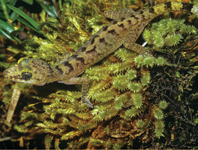Abstract
Pseudophoxinus cilicicus, new species, is described from the Arsuz, Ceyhan and Seyhan river drainages in the Gulf of İskenderun. It is distinguished from other members of the Pseudophoxinus zeregi species group by having a complete lateral line with 38–45 + 2–3 scales, the lower lip usually slightly projecting beyond the tip of the upper lip, a prominent black stripe along the flank, and no black pigments below the lateral line. Pseudophoxinus cilicicus is distinguished from P. zekayi by a minimum K2P distance of 3.8% based on the mitochondrial DNA barcode region. Pseudophoxinus atropatenus and P. sojuchbulagi are returned to the genus Rutilus.
References
Abdurakhmanov, Y.A. (1950) New species of roach, Rutilus sojuchbulagi sp. nova. Doklady Akademii Nauk Azerbaidzhanskoi SSR, 6 (3), 112–116.
Bariche, M. & Freyhof, J. (2016) Status of Pseudophoxinus libani and P. kervillei, two minnows from the Levant (Teleostei: Cyprinidae). Ichthyological Exploration of Freshwaters, 27 (3), 203–210.
Biomatters (2013) Geneious Pro. Available from: http://www.geneious.com (accessed 26 August 2019)
Bogutskaya, N.G., Küçük, F. & Atalay, M.A. (2006) A description of three new species of the genus Pseudophoxinus from Turkey (Teleostei: Cyprinidae: Leuciscinae). Zoosystematica Rossica, 15, 335–341.
Derjavin, A.N. (1937) A new species of roach Rutilus (Orthroleucos) atropatenus nov. sp. from Azerbaijan. Trudy Azerbaidzhanskogo Filiala, Akademii Nauk SSSR, Zoolocicheskij Serija, 20, 71–78.
Edgar, R.C. (2004) MUSCLE: Multiple sequence alignment with high accuracy and high throughput. Nucleic Acids Research, 32, 1792– 1797.
http://dx.doi.org/10.1093/nar/gkh340
Freyhof, J., Ekmekçi, F.G., Ali, A., Khamees, N.R., Özuluğ, M., Hamidan, N., Küçük, F. & Smith, K.G. (2014) Chapter 3. Freshwater fishes. In: Smith, K.G., Barrios, V., Darwall, W.R.T. & Numa, C. (Eds.), The status and distribution of freshwater biodiversity in the Eastern Mediterranean. IUCN, Cambridge, Malaga and Gland, pp. 19–42.
Geiger, M.F., Herder, F., Monaghan, M.T., Almada, V., Barbieri, R., Bariche, M., Berrebi, P., Bohlen, J., Casal-Lopez, M., Delmastro, G.B., Denys, G.P.J., Dettai, A., Doadrio, I., Kalogianni, E., Kärst, H., Kottelat, M., Kovačič, M., Laporte, M., Lorenzoni, M., Marčič, Z., Özuluğ, M.,Perdices, A., Perea, S., Persat, H., Porcelotti, S., Puzzi, C., Robalo, J., Šanda, R., Schneider, M., Šlechtová, V., Stoumboudi, M., Walter, S. & Freyhof, J. (2014) Spatial heterogeneity in the Mediterranean Biodiversity Hotspot affects barcoding accuracy of its freshwater fishes. Molecular Ecology Resources, 14, 1210–1221.
https://doi.org/10.1111/1755-0998.12257
Ivanova, N.V., Zemlak, T.S., Hanner R.H. & Hebert, P.D.N. (2007) Universal primer cocktails for fish DNA barcoding. Molecular Ecology Notes, 7, 544–548.
http://dx.doi.org/10.1111/j.1471-8286.2007.01748.x
Kapli, P., Lutteropp, S., Zhang, J., Kobert, K., Pavlidis, P., Stamatakis, A. & Flouri, T. (2017) Multi-rate Poisson Tree Processes for single-locus species delimitation under Maximum Likelihood and Markov Chain Monte Carlo. Bioinformatics, 33 (11), 1630–1638.
https://doi.org/10.1093/bioinformatics/btx025
Kimura, M. (1980) A simple method for estimating evolutionary rates of base substitutions through comparative studies of nucleotide sequences. Journal of molecular evolution, 16 (2), 111–120.
https://doi.org/10.1007/BF01731581
Knebelsberger, T., Dunz, A.R., Neumann, D. & Geiger, M.F. (2015) Molecular diversity of Germany’s freshwater fishes and lampreys assessed by DNA barcoding. Molecular Ecology Resources, 15 (3), 562–572.
https://doi.org/10.1111/1755-0998.12322
Kottelat, M. & Freyhof, J. (2007) Handbook of European freshwater fishes. Kottelat, Cornol and Freyhof, Berlin, xiv + 646 pp.
Krupp, F. (1985) Systematik und Zoogeographie der Süsswasserfische des levantinischen Grabenbruchsystems und der Ostküste des Mittelmeers. Dissertation, Johannes Gutenberg Universität, Mainz, 215 pp.
Krupp, F. (1992) Two new species of cyprinid fishes from the Mediterranean coastal drainage basin of Syria (Pisces: Osteichthyes: Cyprinidae). Senckenbergiana Biologica, 72 (1/3), 19–25.
Krupp, F. & Schneider, W. (1989) Fishes of the Jordan River drainage basin and Azraq Oasis. Fauna of Saudi Arabia, 10, 347–416.
Kumar, S., Stecher, G. & Tamura, K. (2016) MEGA7: Molecular Evolutionary Genetics Analysis Version 7.0 for Bigger Datasets. Molecular Biology and Evolution, 33(7):1870–1874.
https://doi.org/10.1093/molbev/msw054
Küçük, F. & Güçlü, S.S. (2014) A new Pseudophoxinus (Teleostei, Cyprinidae) species from Asi River Drainage (Turkey). ZooKeys, 411, 57–66.
https://doi.org/10.3897/zookeys.411.6833
Masters, B.C., Fan, V. & Ross, H.A. (2011) Species delimitation—a geneious plugin for the exploration of species boundaries. Molecular Ecology Resources, 11, 154–157.
http://dx.doi.org/10.1111/j.1755-0998.2010.02896.x
Perea, S., Böhme, M., Zupančič, P., Freyhof, J., Šanda, R., Özuluğ, M., Abdoli, A. & Doadrio, I. (2010) Phylogenetic relationships and biogeographical patterns in Circum-Mediterranean subfamily Leuciscinae (Teleostei, Cyprinidae) inferred from both mitochondrial and nuclear data. BMC Evolutionary Biology, 10 (1), 265.
https://doi.org/10.1186/1471-2148-10-265
Saç, G., Özuluğ, M., Elp, M., Gaffaroğlu, M., Ünal, S., Karasu Ayata, M., Kaya, C., Freyhof, J. (2019) New records of Pseudophoxinus firati from Turkey (Teleostei: Leuciscidae). Journal of Applied Ichthyology, 1, 1–6.
https://doi. org/10.1111/jai.13869
Saitou, N. & Nei, M. (1987) The neighbor-joining method: a new method for reconstructing phylogenetic trees. Molecular Biology and Evolution, 4 (4), 406–425.
https://doi.org/10.1093/oxfordjournals.molbev.a040454
Swofford, D.L. (2002) PAUP*. Phylogenetic analysis using parsimony (*and other methods). Version 4, Sinauer Associates, Sunderland. MA. [program]
Zhang, J., Kapli, P., Pavlidis, P. & Stamatakis, A. (2013) A general species delimitation method with applications to phylogenetic placements. Bioinformatics, 29 (22), 2869–2876.
https://doi.org/10.1093/bioinformatics/btt499

